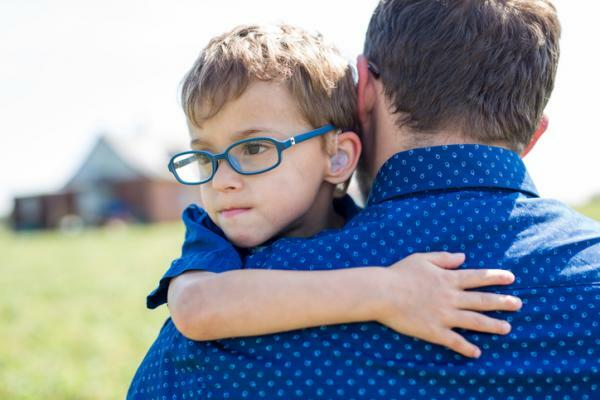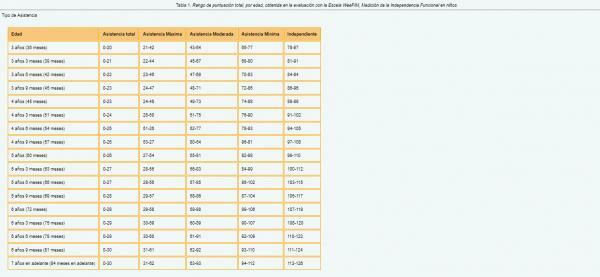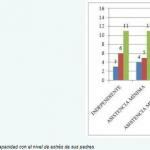
To know the relationship between the stress level of parents and the degree of dependency of their children with disabilities, a descriptive, correlational, cross-sectional study was carried out with users of the Teletón Baja California Sur Children's Rehabilitation Center.
To measure the stress level of the parents, the Stress Appreciation Scale, which was compared with the degree of dependency of their children according to the WeeFIM scale (Wee - Functional Independence Measure) - Measurement of Functional Independence in children, for data analysis the Pearson test was used to find correlation. For this purpose, the nominal information was translated into numerical information. Obtaining as a result that the level of stress of the parents and the level of dependency of the children with disabilities does not present a directly proportional relationship, observing, on the contrary, an inversely related relationship proportional.
In this PsychologyOnline article, we will present a Comparison of stress in parents and the level of dependency of the child with a disability.
Index
- State of the question
- Theoretical framework
- Methodological design
- Method
- Results:
- Conclusions
State of the question.
The general objective of this study is to determine if there is an increase in the level of stress of the parents of children with disabilities when the degree of dependence for the activities of daily living of their children is higher.
It is important to recognize that while it is true that all children provide parents with a mixture of concerns and joys, parents of a child with a disability often continue to practice what might be called active parenting longer than most.
The more handicapped the child, the harder it is for parents not to have to deal with it. Among caregivers of totally dependent children, there is great concern about who will take care of their child, when they are gone, (Sinason, 1999) mainly due to the fact that their children tend to be more dependent on carrying out the basic activities of daily life, which are characterized by being universal, being linked to survival and human condition, basic needs, being directed at oneself and suppose a minimum cognitive effort, automating its execution early, around 6 years of age, in order to achieve independence personal. Usually within the ABVD, food, toilet, bathing, clothing, personal mobility, sleep and rest are included. (Moruno & Romero, 2006)
On the other hand, there are certain weighty factors that also exert their influence on the family and are all those specifically linked to the deficit. Thus, for example, the type of disorder of the child, be it sensory, motor and / or mental, and the degree of commitment of the same. Then a huge feeling of responsibility appears to the needs imposed by disability. Therefore what is given and what is received does not seem to be enough. There is something missing that can never be fully covered.
Having a child with a deficit imposes a new challenge: how to remain a person, as well as the father of that child. It seems to forget the fact that parents are, first of all, people. The comings and goings to the specialists' offices, the permanent satisfaction of the physical needs of your child more demanding and dependent on them, the reinforcement of rehabilitation exercises and the cost of treatments. A mountain of demands and responsibilities usually falls on their shoulders, preventing their own space and denying any possibility of pleasure. The mother is the one who is usually the most trapped in the situation. (Núñez, 2010).
Theoretical framework.
Luna, et al (2012) conclude that some changes emerge in the organization of families with children with disabilities from the moment of the news and last until the child is an adult. Among them are the affectations at the couple level, that is, between spouses, modifications can be found in marital life, from the abandonment of the couple to new forms of interaction between the spouses, such as, for example, the intervention of the man in the upbringing of children from the woman's labor insertion, etc. Which could be perceived as adverse stimuli, causing, in addition to negative emotional responses, damage to people's health.
Many of these damaging effects they are produced not by the stimuli themselves, but by the reactions to them. Therefore, the expression of negative emotions can have unfavorable effects on those who experience them and on those with whom they interact. Walter Cannon, (cited by Carlson, 1996) the physiologist who criticized the James-Lange theory, introduced the term stress, to refer to the physiological reaction caused by the perception of adverse situations or threatening.
In the studies carried out by Nauert (2009) on parental stress with children with special needs, it was found that parents of children with disabilities had a greater degree of stimuli that caused them stress and a greater number of days in which they had at least one stimulus that generated stress, compared to parents who had children without disabilities. They also experienced a greater number of physical problems related to health problems.
On the other hand, saliva samples were evaluated to measure the level of Cortisol (a biological marker that plays an important role in binding exposure to stress to health problems) and it was obtained by response that the daily patterns of Cortisol of parents of children with disability, were chronically elevated to a much higher level than normal, on days when parents spent more time with their children.
On the other hand, Martínez, et al (2012) in the studies they carried out to determine if there was a correlation between caregiver burden and perceived dependency In a sample of informal caregivers of children with severe cerebral palsy, they found that only one group reduced perceived an intense load and the majority considered as totally dependent on the physical aspect to the minors.
Pearson's correlation analysis showed that the perception of physical dependence of care recipients is not related to caregiver burden, Therefore, it is concluded that in this sample of caregivers, physical dependence in patients does not influence the perceived burden. (Martínez, et al, 2012) In professional practice it is observed that on some occasions the level of parental stress is related to a greater or lesser degree with the level of dependence on the ABVD of children with a disability and, taking into account the studies carried out, it can be seen, on the one hand, that parents with a child with a disability receive more stimuli that cause them stress compared to parents that their children do not have disabilities (Nauert, 2009) and, on the other hand, it is observed that caregivers informal reports of minors with severe cerebral palsy, who consider these minors to be totally dependent on their physical appearance, do not perceive that their care implies a higher load. (Martínez, et al, 2012).
Based on this, a descriptive, correlational, cross-sectional study was carried out to determine the relationship that exists between the appreciation of stress in the parents of children. with disabilities with the level of dependence of the child for activities of daily living, taking into account a population of minors with different types of disability.
The results obtained show that the level of parental stress is not directly related to the greater degree of dependence of the children with disabilities in terms of their ABVD, but on the contrary, it is inversely proportional, thus being that the higher the degree of The dependence of the children, the less stress on the parents and the lower the degree of dependency, the higher the level of stress parental.
These findings allow rethink the care needs of families who have a minor with a disability, from a different perspective since it is usually considered that when the deficit is greater, the need for parental care and burnout is also greater (Núñez, 2010).
Methodological design.
In order to determine if there is an increase in the level of stress of the parents of children with disability when the degree of dependence for the basic activities of daily living is greater, it is carried out a descriptive, correlational, cross-sectional research to determine if such a relationship exists and thus, to be able to verify or discard the assumption that the greater degree of dependence for the ABVD of a minor with a disability, increases the stress level of the fathers.
The study was carried out at the Teletón Baja California Sur Children's Rehabilitation Center, where minors with disabilities who present disorders of neuro-musculoskeletal origin, which present alterations to health states that affect the nervous, muscular and bone systems (neuromusculoskeletal system and related to movement) that have an impact on body posture, muscle tone and / or quality of movement (skills motor).
Each of the neuromuscular disorders presents a variety of different symptoms and signs, which lead to functional disability in relation to the degree of independence in ABVD. (Telethon, 1999-2009) The research was approved by the internal Ethics and Research committee of the Centro de Rehabilitación Infantil Teletón de Baja California Sur, being registered with the number 1402.

Method.
Participants
The characteristics of the study population consisted in that they were fathers and / or mothers of children with disabilities, active in the CRIT BCS in the period in which the scales were applied and that their children had any of the following disorders: spinal cord injury, diseases neuromuscular, osteoarticular diseases, congenital and genetic diseases and children under four with brain injury or neurological damage already settled down. Conforming a total population of 300 patients. A simple affixation stratified random probability sampling was carried out to obtain a total sample of 100 participants, distributed in 5 strata according to the degree of assistance required by patients to perform their ABVD.
Material and method
In order to identify the level of stress in parents of children with disabilities, the Stress Appreciation Scale, in its General Stress Scale section to obtain the evaluation of the incidence and intensity with which different stressful situations affect the life of each subject. Intensity is measured with a Likert-type scale from 0 (not at all) to 3 (very much). (Mielgo & Fernández-Seara, 2014).
To Identify the degree of dependency for the activities of daily living of children with disabilities, the clinical record of patients, prior authorization of the parents by signing the informed consent, and the results obtained from the application of the WeeFIM Scale (Wee - Functional Independence Measure) - Measurement of Functional Independence in children. This scale consists of 18 elements that include three areas: personal care, mobility and cognition, applicable to children and young people from 6 months of age to 21 years.
The evaluation of each of the elements is from 1 to 7 points, achieving a maximum of 126 points, which varies depending on their age as shown Table 1. This scale was chosen, since it determines the severity of the disability and the need for assistance, since it assesses the degree of completion of activities of daily living and independence. (WeeFIM, 1998, 2000)

Based on the information obtained, 20 study participants were distributed to each of the strata managed by WeeFIM, as indicated in the Table 2. And the level of stress in parents was correlated with the degree of dependence of the children for activities of daily living. T
They were taken into account as intervening variables, sex, age, socioeconomic status, and number of children of the study participants.
The socioeconomic level of the participants was obtained in the same way, from the data contained in the clinical file, matching said information with the criteria established by the AMAI Rule 8X7 Mexican Association of Market Intelligence and Opinion Agencies (AMAI, 2011), grouping them into 3 socioeconomic strata or levels, the high level being strata A, B, C +; medium level, strata C, C-, D + and the low level, strata D and E.
For him analysis of data the statistical package was used SPSS For Windows version 20, the test of Pearson to look for correlation, since the sample had a normal distribution. For this purpose, the nominal information was translated into numerical information.

Results:
The sample of 100 parents had a positive leptocurtic asymmetry curve, but the Kolmogorov-Smirnov test of .169 demonstrated a normal distribution, for this reason the Pearson test was selected to look for correlation, since the sample had a distribution normal.
It is observed that in the sample the primary caregivers are mostly of gender 97% female, compared to 3% for males.
The age of the caregivers Primary was between 24 and 58 years of age and the age of children with disabilities ranged from 3 years of age to 19 years of age.
The number of children of the sample was between 1 to 6, with 21% of families with only 1 child and 79% of those with more than 1 child.
The socioeconomic level of the study participants ranged from the middle level 47% to the low level 53%, with none found from the high level 0%.
The stress levels presented in the primary caregivers were: high 9%, medium 32%, low 59%.
Regarding the relationship between the level of stress of the parents and the level of dependency of the children with disabilities, it is shown that there is no directly proportional relationship between these, observing on the contrary an inversely proportional relationship as shown in Figure 1.
Which tells us that the level of stress is higher in families that have a child with a disability who requires minimal assistance and secondly, families, in which your child is at a level of independence. The stress level was lower in families with a child requiring full assistance.
Figure 1. Association between the level of dependency of children with disabilities and the level of stress of their parents.
Correlations were made between the level of parental stress and the intervening variables:
- level of dependency of the child with a disability,
- sex,
- parents' age,
- age of the child with a disability,
- socioeconomic level,
- number of children,
- place occupied by the disabled child,
In order to know if any of these factors had a direct influence on the stress level of the parents.
The results obtained indicated that no statistically significant correlation was found, between the stress level of the parents and these variables, as indicated in Table 4.
Correlation between the level of parental stress and the level of dependency of the child with a disability, sex, age of the parents, the age of the child with a disability, the socioeconomic status, the number of children and the place of the child with disability.

Conclusions.
The study showed that having a child with a disability does indeed generate some degree of stress and that the mother is usually the one who is more trapped in the situation, being the primary caregivers, mostly female (97%), as expressed by Núñez (2010).
Based on the results obtained in the study, it was shown that the greater degree of dependence for the basic activities of daily life of a minor with Disability does not have a directly proportional relationship with the level of parental stress, similar to what was found in the investigations of Martínez, et al. al (2012), who correlated the degree of physical dependence with the perceived burden of the primary caregiver in a population of minors with paralysis cerebral. On the contrary, it was found that the level of stress is inversely proportional, being higher in families that have a child with a disability who requires minimal assistance and less in families with a child who requires full assistance.
For the present study, other types of disabilities were taken into account, adding other factors to clarify the possible cause of stress: sex of the primary caregiver, age of the caregiver primary school, age of the disabled child, socioeconomic status, number of children and place of birth that the disabled child occupies among their siblings, in addition to the degree of dependence on the ABVD. Without finding significant correlations, which would relate any of these factors to a higher level of parental stress.
This means that parental stress was not directly related to the level of dependency of the child with a disability, nor to the other variables: leading to deny the working hypothesis: The greater degree of dependence for the activities of daily living, of a minor with a disability, increases the stress level of the children. fathers. And to affirm the null hypothesis: The highest degree of dependency for activities of daily living of a minor with a disability, does not increase the stress level of parents. These findings allow us to rethink the care needs of families who have a minor with a disability, from a perspective different since it is usually considered that when the deficit is greater, the need for parental care and burnout is also greater (Núñez, 2010).
Now, it is important to continue or delve further into this type of study that allow us to propose new hypotheses in order to identify the causes or motives that may be influencing the perception of Primary caregiver stress, such as families who have a child in need of full assistance, may find themselves Resigned to the disability status of their child and families who have children who require minimal assistance or are independent, They probably present a higher level of stress due to the expectations they may have regarding their development or the lack of acceptance of the diagnosis itself.
Anyway, as you can see, these results open new lines of research, that allow giving an answer on what are the characteristics or factors that intervene so that the parents of children with disabilities, who require minimal assistance or are independent, present higher levels of stress. Similarly, to know the factors that intervene so that parents of children with disabilities who require full assistance, present a lower level of stress, in relation to the former.
Based on the results, it can be inferred that the sector of the population of parents who have a child with a disability, who requires minimal assistance or are independent, need, to a greater extent, psychological treatments that allow them to achieve an emotional balance that reduces the level of stress.
This article is merely informative, in Psychology-Online we do not have the power to make a diagnosis or recommend a treatment. We invite you to go to a psychologist to treat your particular case.
If you want to read more articles similar to Comparison of stress in parents and the level of dependency of the child with a disability, we recommend that you enter our category of Emotional and behavioral disorders.
Bibliography
- AMAI, C. N. (2011). AMAI 8X7 RULE UPDATE. (H. López, Ed.) Obtained from http://www.amai.org/NSE/PRESENTACION_REGLA_8X7.pdf
- Carlson, N. R. (1996). Fundamentals of Physiological Psychology. MEXICO: PRENTICE- HALL HISPANOAMERICANA, S.A.
- Cid-Ruzafa, J. (2007). Assessment of Physical Disability: The Barthel index. Spanish magazine of Public Health.
- INEGI. (2010). Disability in Mexico INEGI. Retrieved on February 25, 2014, from the 2010 Population and Housing Census: http://cuentame.inegi.org.mx/poblacion/discapacidad.aspx? topic = P
- Luna, A. R., Velázquez, T. L., Garduño, G. A., & Silva, O. P. (April 12, 2012). Changes in family dynamics with disabled children. Scientific Psychology.com, 16, volume 16. Retrieved on March 29, 2014, from http://www.psicologiacientifica.com/hijos-con-discapacidad-cambios-familia/
- Martínez, L. C., Ramos, d. R., Robles, R. M., Martínez, G. D., Martínez, L. C., & Figueroa, L. C. (July-December 2012). Burden and dependency in informal primary caregivers of patients with severe infantile cerebral palsy. Psychology and Health, 22(2), 275-282. Retrieved on April 5, 2014, from http://teleton.org/carga-y-dependencia-en-cuidadores-primarios-informales-de-pacientes-con-paralisis-cerebral-infantil
- Mielgo, M., & Fernández-Seara, J. (2014). TEA Editions. Retrieved on February 25, 2014, from EAE, Stress Appreciation Scales: http://web.teaediciones.com/eae-escalas-de-apreciacion-del-estres.aspx
- Moruno, P., & Romero, D. (2006). Daily life activities. Barcelona: Masson.
- Nancy E. Reichman, H. C. (2008). Impact of Child Disability on the Family. Matern Child Health, 679-683.
- Nauert, R. (2009, February 26). Parental Stress With Special-Needs Children. Journal of Health and Social Behavior, 679-683. Retrieved from http://psychcentral.com/news/2009/02/19/parental-stress-with-special-needs-children/4219.html
- Núñez, B. (2010). The child with a disability, the family and his teacher. (1st. ed.). Buenos Aires: Publishing place.
- Reed, K., & Sanderson, S. (1980). Concepts of Occupational Therapy. Baltimore: Williams and Wilkins.
- Reichman, N. E., Corman, H., & Noonan, K. (2008). Impact of Child Disability on the Family: Medscape Multispecialty. (S. S. Media, Ed.) Matern Child Health Journal, 6(12), 679-683. Retrieved March 26, 2014, from Medscape Multispecialty: http://www.medscape.com/viewarticle/581577_2
- Segovia, L. D., & Ortiz, O. D. (April-June 2005). Evaluation of functional performance of patients with Cerebral Palsy Se.
Photos of Comparison of stress in parents and the level of dependency of the child with a disability



